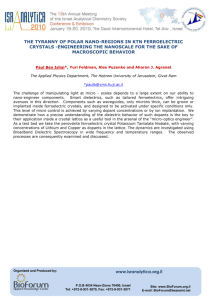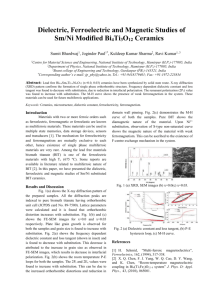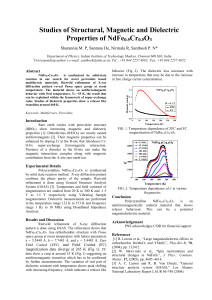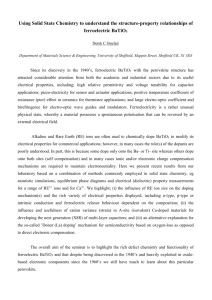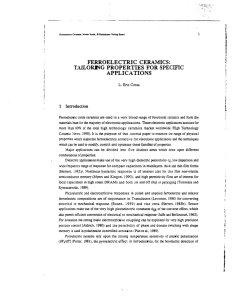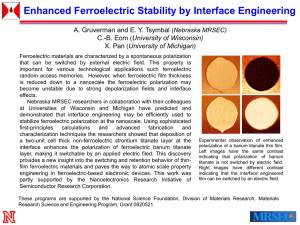1-x - DSpace - National Institute of Technology Rourkela
advertisement
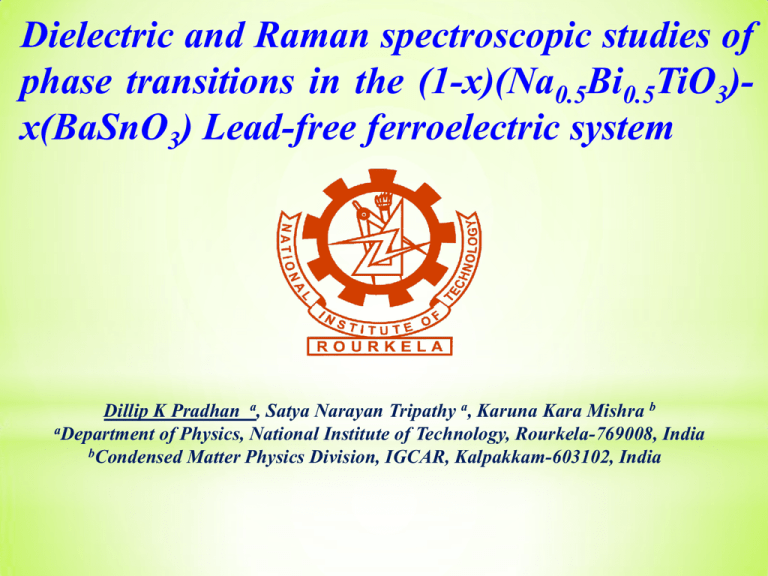
Dielectric and Raman spectroscopic studies of phase transitions in the (1-x)(Na0.5Bi0.5TiO3)x(BaSnO3) Lead-free ferroelectric system Dillip K Pradhan a, Satya Narayan Tripathy a, Karuna Kara Mishra b aDepartment of Physics, National Institute of Technology, Rourkela-769008, India bCondensed Matter Physics Division, IGCAR, Kalpakkam-603102, India Plan of presentation Introduction. Why Na0.5Bi0.5TiO3 (NBT)? Problems to be addressed. Objectives. Results and Discussion Summary and conclusions Introduction Ferroelectric materials have permanent dipoles and so there molecular structure lack center of symmetry. All ferroelectric crystals must be piezoelectric though the converse is not true. All ferroelectric materials have one or more phase transition temperatures. Structural change take place at the curie temperature. Immediately above the curie temperature, the dielectric constant of a ferroelectric material obeys Curie -Wiess law . A ferroeletric is generally defined as one of which exhibits hysterisis loop. 1)spontaneous Polarization (Ps) 2)Remnant Polarization (Pr) 3)Coercive Field (Ec) Most studied material BT (BaTiO3) PZT (Pb(ZrxTi1−x)O3 ) PLZT (Pb1−xLax(ZryT1−y)1−x/4O3) PMN (Pb(Mg1/3Nb2/3O3)- PT(PbTiO3) Why Lead free Lead (Pb) release into the environment at time of processing and remain for a long time in the environment and accumulates in living tissues which damages the brain and nervous system. It could introduce to the ecosystem and cause “acid rain”. Restoring and recycling of lead-based materials is an extensive environmental issues. Why (Na0.5Bi0.5 )TiO3? Lead free compound. Ferroelectric at room temperature. Complex phase transitions sequence & anomalies dielectric behaviors. High Curie temperature (Tc >320 0C) . Large Remnant polarization. Bi+3 ions are isoelectronic configuration with Pb+2, both showing a lone pair effect. Sequence of Phase transitions NBT Rhombohedral (R3c) Td (200-280 oC) Modulated Orthorhombic (R3c+ Pnma) TA-O Orthorhombic (Pnma) TC Second order Phase transition (~320 oC) Tetragonal (P4/mbm+P42/mnm) First order phase transition Cubic (520-540 oC) (Pm-3m) •G. Trolliard and V. Dorcet, Chem. Mater. 20, 5074 (2008). •V. Dorcet, G. Trolliard, and P. Boullay, Chem. Mater. 20, 5061 (2008). Problems Addressed High coercive field 73 KV/cm. High conductivity cause problem during polling. High Dielectric loss. Low piezoelectric and electromechanical properties i.e. d33 of 92 pC/N and Kp coupling coefficients 18.6. To overcome the above mentioned problems, we have synthesized (1-x)Na0.5Bi0.5TiO3–xBaSnO3 ( 0 ≤ x ≤ 0.15) Objective Our main objective is to (i) reduce the high dielectric loss and conductivity (ii)improve the dielectric and ferroelectric properties. (iii)study the fundamental physics related to phase transition of NBT-BaSnO3 System. 1.Ferroelectric to relaxor crossover(1-x)BaTiO3-xBaSnO3 2.Relaxor ferroelectric behavior of BaSnO3-PbTiO3 solid solution with MPB 1. C. Lei, A. A. Bokov, and Z. G. Ye, J. Appl. Phys. 101, 084105 (2007). 2. X. Han, X. Li, X. Long, H. He, and Y. Cao, J. Mater Chem. 19, 6132 (2009). (Na0.5Bi0.5) Ti O3 (A and B site Modification) Na2CO3 BaCO3 Bi2O3 SnO2 TiO2 Dry Mixing Wet Mixing Calcination Formation Grinding Recalcination Cold Pressing Materials Preparation Sintering Polishing Electroding Characterization Checked by XRD NO YES Materials Characterization Structure Determination XRD analysis (PANalytical's X'Pert PRO) Raman Spectroscopy Ranishaw micro-Raman spectrometer (ModelINVIA) Dielectric, Impedance Measurement PSM LCR 4NL, Model: 1735, UK 10 Structural Studies * ICDD No 74-1318 * x = 0.15 Intensity (A.U) x = 0.12 x = 0.1 x = 0.08 x = 0.05 x = 0.03 x = 0.00 20 30 40 50 60 o Bragg Angle (2 ) 70 80 *Na0.5Bi4.5Ti4O15 (ICDD No 74-1318). For, 0≤ x ≤ 0.08; Rhombohedral For, 0.1≤ x ≤ 0.15; Orthorhombic For, NBT a = b = 5.4972(17) Å and c = 13.4551(21) Å Dielectric Studies 3.0 1.0 0.5 (a) x = 0.00 Zone-I 100 200 300 400 o Temperature( C) tan 0.3 Td 1.5 0.4 TA-O Zone-II 2.0 TC 1 kHz 5 kHz 10 kHz 50 kHz 100 kHz 500 kHz r 103 2.5 0.5 0.2 0.1 0.0 500 350 300 o Temperature( C) 100 kHz 250 Td TA-O 150 TC 100 0.00 0.05 0.10 Composition (x) 0.15 a) Appearance and enhancement of modulated orthorhombic phase b) Decrease in ferroelectric transition temperature 2nd Order Phase transition 6 0.8 TC= 335 C 2 0.6 0 0.4 -2 -4 -6 4 1/ 200 300 o Temperature( C) 400 0.2 0.0 o C o 1.0 x = 0.05 100 kHz (b) 0.8 o TC= 303 C 2 (a) x = 0.00 100 kHz 1/ C 4 1.0 0.6 0 0.4 -2 -4 -6 1/ 200 For, x=0.00 ξ 320oC/ ξ 350oC ≈ 2.6 300 o Temperature( C) 1/ 6 400 0.2 0.0 Raman Spectroscopy A. Compositional Dependence 100 600 (a) x = 0.08 x = 0.05 x = 0.03 x = 0.00 85 (b) (a) IA/IQ x = 0.1 500 -1 x = 0.12 90 Mode frequency (cm ) Intensity (arb. units) x = 0.15 95 400 80 75 70 300 65 200 60 55 100 100 200 300 400 500 600 700 -1 Raman shift (cm ) 50 0.00 0.05 0.10 Composition (x) 0.15 0.00 0.04 0.08 0.12 Composition (x) Mode (~278 - ~585 cm-1) are associated with the TiO6 octahedral vibration. Disappearance of A1-mode at ~134 cm-1 as the sample undergoes a structural phase transition from rhombohedral to orthorhombic at x = 0.1 composition. 0.16 Conclusion To conclude, lead free solid solutions of (1-x)NBT-xBSN (0≤ x ≤ 0.15) were synthesized by solid-state reaction method. Phase transition temperatures Td, TA-O and TC were obtained from the detailed dielectric data analysis. A decrease in ferroelectric phase transition temperature as a function of x is obtained and finally TC merges with TA-O at composition x = 0.15. In-situ temperature dependent Raman spectroscopy shows disappearance and discontinuous changes in the phonon mode frequencies across the orthorhombic-tetragonal phase transition. Acknowledgement We acknowledge Prof. R. N. P Choudhary & Prof. A. K. Arora for fruitful discussions.
